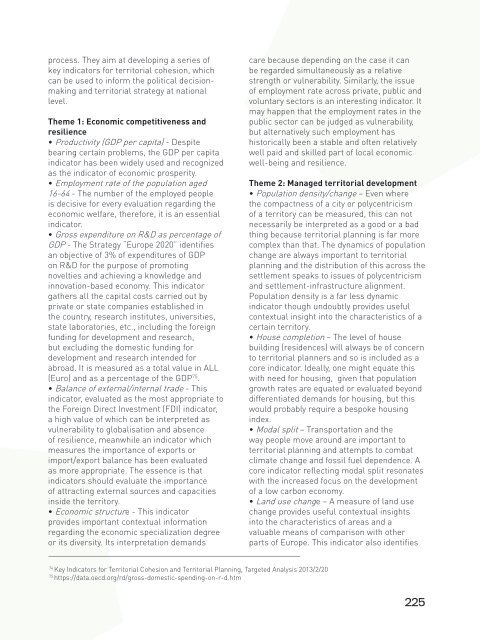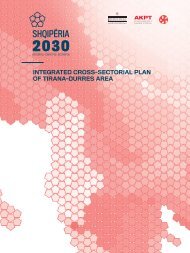General National Spatial Plan / Shqipëria 2030
The General National Spatial Plan (GNSP) provides the strategic reference framework for sustainable territorial development for the next 15 years, in order to ensure balanced economic and social national development, responsible management of natural resources, environmental protection, all while ensuring the rational land use. The GNSP is introduced not only as fulfillment of a legal obligation, but also as a prerequisite to achieving the governmental program objectives to enhance citizens’ welfare and national economic growth by reducing inequalities, strengthening the strategic partnership with neighboring countries and implementation of policies that foster competitiveness of economic sectors, thus ensuring integration in the European Union.
The General National Spatial Plan (GNSP) provides the strategic reference framework for sustainable territorial development for the next 15 years, in order to ensure balanced economic and social national development, responsible management of natural resources, environmental protection, all while ensuring the rational land use. The GNSP is introduced not only as fulfillment of a legal obligation, but also as a prerequisite to achieving the governmental program objectives to enhance citizens’ welfare and national economic growth by reducing inequalities, strengthening the strategic partnership with neighboring countries and implementation of policies that foster competitiveness of economic sectors, thus ensuring integration in the European Union.
Create successful ePaper yourself
Turn your PDF publications into a flip-book with our unique Google optimized e-Paper software.
process. They aim at developing a series of<br />
key indicators for territorial cohesion, which<br />
can be used to inform the political decisionmaking<br />
and territorial strategy at national<br />
level.<br />
Theme 1: Economic competitiveness and<br />
resilience<br />
• Productivity (GDP per capita) - Despite<br />
bearing certain problems, the GDP per capita<br />
indicator has been widely used and recognized<br />
as the indicator of economic prosperity.<br />
• Employment rate of the population aged<br />
16-64 - The number of the employed people<br />
is decisive for every evaluation regarding the<br />
economic welfare, therefore, it is an essential<br />
indicator.<br />
• Gross expenditure on R&D as percentage of<br />
GDP - The Strategy “Europe 2020” identifies<br />
an objective of 3% of expenditures of GDP<br />
on R&D for the purpose of promoting<br />
novelties and achieving a knowledge and<br />
innovation-based economy. This indicator<br />
gathers all the capital costs carried out by<br />
private or state companies established in<br />
the country, research institutes, universities,<br />
state laboratories, etc., including the foreign<br />
funding for development and research,<br />
but excluding the domestic funding for<br />
development and research intended for<br />
abroad. It is measured as a total value in ALL<br />
(Euro) and as a percentage of the GDP 75 .<br />
• Balance of external/internal trade - This<br />
indicator, evaluated as the most appropriate to<br />
the Foreign Direct Investment (FDI) indicator,<br />
a high value of which can be interpreted as<br />
vulnerability to globalisation and absence<br />
of resilience, meanwhile an indicator which<br />
measures the importance of exports or<br />
import/export balance has been evaluated<br />
as more appropriate. The essence is that<br />
indicators should evaluate the importance<br />
of attracting external sources and capacities<br />
inside the territory.<br />
• Economic structure - This indicator<br />
provides important contextual information<br />
regarding the economic specialization degree<br />
or its diversity. Its interpretation demands<br />
care because depending on the case it can<br />
be regarded simultaneously as a relative<br />
strength or vulnerability. Similarly, the issue<br />
of employment rate across private, public and<br />
voluntary sectors is an interesting indicator. It<br />
may happen that the employment rates in the<br />
public sector can be judged as vulnerability,<br />
but alternatively such employment has<br />
historically been a stable and often relatively<br />
well paid and skilled part of local economic<br />
well-being and resilience.<br />
Theme 2: Managed territorial development<br />
• Population density/change – Even where<br />
the compactness of a city or polycentricism<br />
of a territory can be measured, this can not<br />
necessarily be interpreted as a good or a bad<br />
thing because territorial planning is far more<br />
complex than that. The dynamics of population<br />
change are always important to territorial<br />
planning and the distribution of this across the<br />
settlement speaks to issues of polycentricism<br />
and settlement-infrastructure alignment.<br />
Population density is a far less dynamic<br />
indicator though undoubtly provides useful<br />
contextual insight into the characteristics of a<br />
certain territory.<br />
• House completion – The level of house<br />
building (residences) will always be of concern<br />
to territorial planners and so is included as a<br />
core indicator. Ideally, one might equate this<br />
with need for housing, given that population<br />
growth rates are equated or evaluated beyond<br />
differentiated demands for housing, but this<br />
would probably require a bespoke housing<br />
index.<br />
• Modal split – Transportation and the<br />
way people move around are important to<br />
territorial planning and attempts to combat<br />
climate change and fossil fuel dependence. A<br />
core indicator reflecting modal split resonates<br />
with the increased focus on the development<br />
of a low carbon economy.<br />
• Land use change – A measure of land use<br />
change provides useful contextual insights<br />
into the characteristics of areas and a<br />
valuable means of comparison with other<br />
parts of Europe. This indicator also identifies<br />
74<br />
Key Indicators for Territorial Cohesion and Territorial <strong>Plan</strong>ning, Targeted Analysis 2013/2/20<br />
75<br />
https://data.oecd.org/rd/gross-domestic-spending-on-r-d.htm<br />
225
















